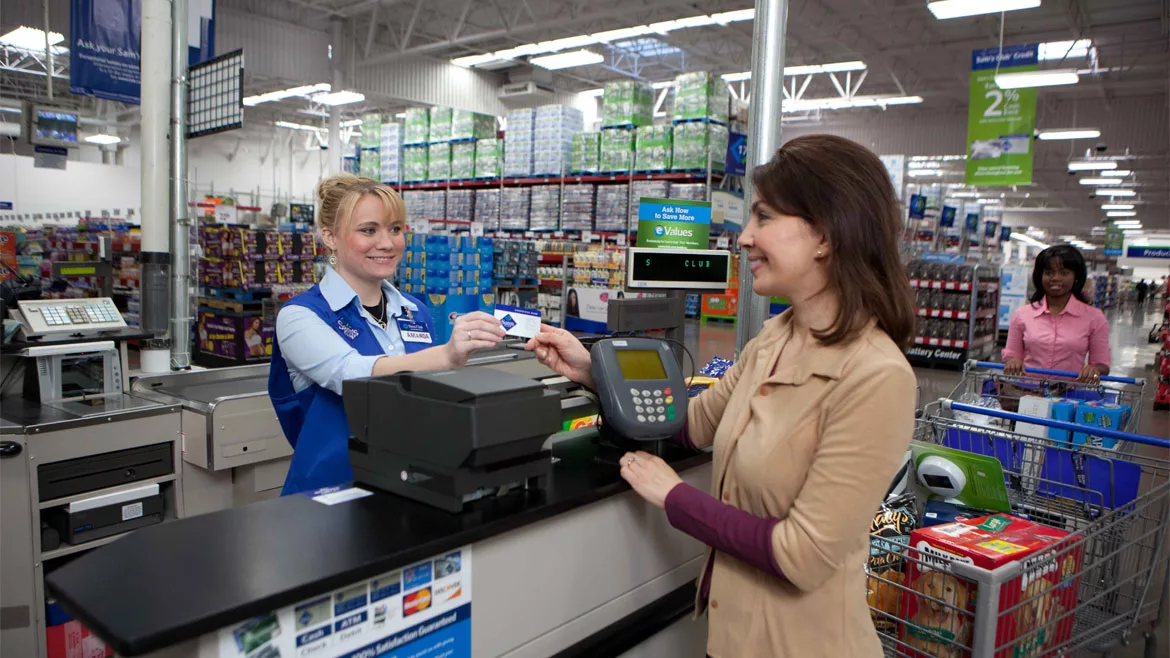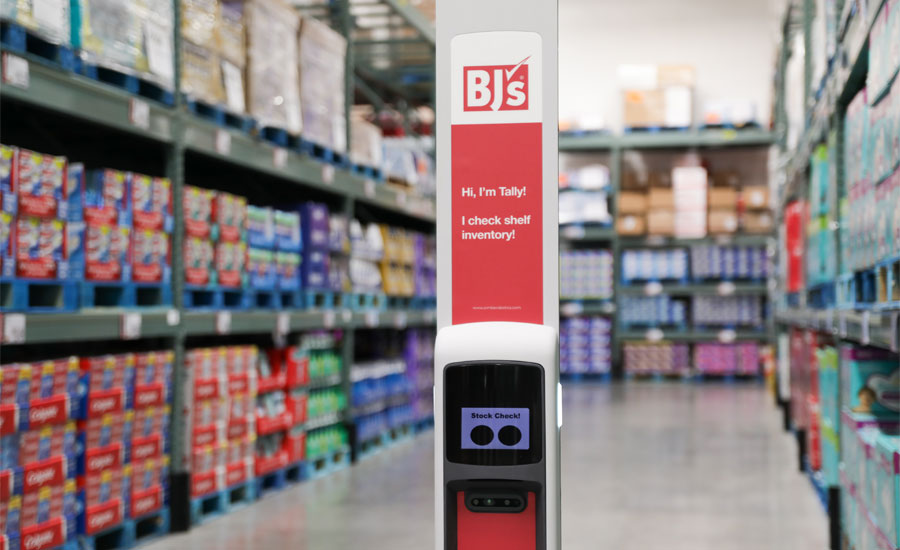Channel Strategies
Club stores help consumers fulfill their quest for value
Technology elevates club store experience, online presence

Image courtesy of Sam’s Club/Walmart Inc.
In the episode “Curry Quest” from the popular children’s program “Bluey,” Mum (Chilli) narrates to Bluey what a quest is and how the hero must navigate challenges. Viewers see Chilli’s narration come to life as Dad (Bandit) and Bingo head to the neighbors for a curry swap while having to brave a magpie that swoops down to protect her nest when they pass through the park. Bingo’s curry quest sees the young Heeler as not just brave and able to maneuver the magpie, but also able to cope with Dad’s upcoming work travels.
Today’s consumers are not on a quest against a protective magpie, but instead a quest for value as inflation and other factors are impacting grocery bills.
“Club stores have been outpacing other formats because they deliver on the quest for value,” says Sally Lyons Wyatt, executive vice president and practice leader of client insights at Chicago-based Circana. “Value at club means different things to different people. It could be price, but also bulk size to feed many in the household. Even the multiple services provided in the store and online attract many shoppers. However, the mass channel has been gaining momentum as they have focused on attracting consumers via price and assortment.”
Christian Perdomo, industry research analyst at IBISWorld, New York, notes how club stores’ offering of a diverse number of products in bulk quantities, featuring competitive prices for its members, has gained favor with consumers for their food and beverage needs.
“Club stores are gaining popularity among consumers for their food and beverage purchases because of various factors like cost savings through bulk purchasing, a wide product selection, membership benefits and the convenience of a one-stop shopping experience,” Perdomo says. “Buying in bulk allows buyers to save money and reduce the frequency of shopping trips, making it an attractive option for cost-conscious customers. Furthermore, during economic instability, consumers tend to lean more toward club stores, seeking effective ways to save on expenses.”
This can be seen when looking at the channel’s performance, with Circana’s Lyons Wyatt noting how well club stores have performed in the past year.
“Dollar and unit sales are showing growth despite 11% average price increase for food and beverages (F&B),” she says “Bottled water, shelf-stable meat, salty snacks, fresh eggs and ice cream/sherbet are some of the categories helping drive these positive trends within F&B.”
In terms of beverage performance, Lyons Wyatt identifies bottled water, coffee, energy drinks and sports drinks as categories that performed well in terms of dollar and unit sales.
“These categories have been adding functional benefits, which has kept consumers coming back for more,” she says. “This has caused some blurring of categories to occur, but they have been able to co-exist within club.”
IBISWorld’s Perdomo points to the bulk purchasing model as part of the reasoning for beverage categories performing well in the channel.
“Club stores offer a variety of popular bulk beverages, including bottled water, soft drinks, juices, sports drinks, coffee, tea and select alcoholic drinks,” he says. “These affordable and conveniently packaged options cater to consumer preferences and hydration needs. Moreover, dairy alternatives like almond, soy and oat milk are becoming popular, attracting those seeking plant-based options or with specific dietary requirements. Demand for these bulk beverages has slightly increased in recent years because of the expanding product range. Also, retailers provide products under their private or in-house brands, like Costco’s Kirkland Signature.”
The aspect of purchasing items in bulk at attractive price points has helped club stores maintain their presence with consumers.
“Thanks to their competitively priced offerings, club stores have successfully catered to a wider customer demographic that aims to mitigate expenditures by purchasing goods in bulk,” Perdomo says. “Furthermore, club stores have concentrated on bolstering their online presence and offering competitive services. This approach enables them to retain market relevance and foster customer loyalty amid the burgeoning eCommerce sector.”

Image courtesy of BJ's Wholesale Club
Digital beyond eCommerce
Although more and more consumers are finding favor with club stores that has not stopped operators in this market from embracing eCommerce as well as other forms of technology to elevate the consumer experience.
“The future of club stores is being significantly influenced by advancements in technology and the growing prevalence of eCommerce,” IBISWorld’s Perdomo says. “The increasing preference for online shopping and the use of mobile applications has ignited a competitive shift toward the digital sphere. Recognizing this trend, club stores now prioritize establishing sophisticated eCommerce platforms and user-friendly mobile apps to retain their clientele.”
Perdomo adds that the COVID-19 pandemic accelerated the digital transformation as well as the demand for contactless shopping experiences.
“To remain competitive, club stores must ensure they can seamlessly integrate both online and offline shopping experiences,” he says “This entails harnessing cutting-edge technologies to cater to the convenience-driven nature of modern-day consumers while preserving the distinct values and attributes offered by traditional physical stores.”
Yet, eCommerce is not the only way that club stores are embracing technology. Earlier this year, BJ's Wholesale Club, Marlborough, Mass., announced its partnership with Simbe to roll out the company’s business intelligence solution, Tally, to all of the company’s stores. Incorporating Simbe’s AI-powered solution into chain-wide operations will provide greater visibility into club conditions and deeper business insights, the company notes.
“We are excited to collaborate with Simbe to bring their industry-leading technology and platform to our clubs,” said Jeff Desroches, executive vice president and chief operations officer at BJ’s Wholesale Club, in a statement. “By deploying Tally in all of our club locations, we will gain unprecedented insights which will leverage real-time data, enabling us to continuously improve our operation and ensure that we’re offering the best possible experience to both our team members and members.”
Tally works by autonomously roaming club aisles multiple times a day, where it leverages computer vision technology to collect accurate shelf data that ensures products are in-stock, shelved appropriately, and accurately priced, according to the company. This real-time data enables faster restocking, directs BJ’s team members to quickly locate products, and provides valuable visibility into inventory tracking, it says.
Additionally, Sam’s Club, a division of Walmart Inc., Bentonville, Ark., announced in February that real-time, intelligently retargeted display advertising is now available across tens of thousands of sites on the open web through Sam’s Club Member Access Platform (MAP). This feature — provided in partnership with The Trade Desk and LiveRamp (RAMP) — leverages first-party member data, advertiser data and AI-powered, real-time behavioral insights from Sam’s Club to make advertising campaigns smarter, more effective and more personalized, according to the company.
Sam’s Club MAP uses real-time, accurate data from registered Sam’s Club members, including exact data on purchase history, demographics, recent purchases of similar items and basket size, the company says. As a result, MAP campaigns can deliver personalized ads in real time to members who’ve expressed interest in a product but have not yet made a purchase, it notes.
Mic Zavarella, vice president of marketing at PepsiCo, expressed excitement over the campaign. “We’ve been waiting a long time to be able to retarget using the real-time data that Sam’s Club has,” he said in a statement at the time of the announcement. “This allows us to automate targeting, personalize messaging and create sophisticated media workflows that maximize the efficiency of our campaigns.”
Circana’s Lyons Wyatt notes that the impact from technology and eCommerce has had a varying affect, but the channel can integrate those advancements in its future.
“For the future, club can continue to lean into their assets to leverage technology and eCommerce and drive to even higher heights,” she says. “Consumers ‘treasure hunt’ in addition to purchasing their essentials when shopping at club stores. It is more complicated to have that same experience online; however, online provides additional benefits for the club channel.”
Despite these hurdles, Lyons Wyatt notes that club stores can utilize technology and eCommerce to enhance the online experience to match the aisles-walking experience.
“For in-store enhancement, in-store engagement could be via robots,” she says. “They will enhance the in-store experience and help shoppers on their journey with fun and engaging interactions. Club will find continued success when they have consumers doing both ― walking and treasure hunting the in-store aisles and online as well.”
Looking for a reprint of this article?
From high-res PDFs to custom plaques, order your copy today!





